52d Expeditionary Flying Training Squadron
| 52d Expeditionary Flying Training Squadron | |
|---|---|
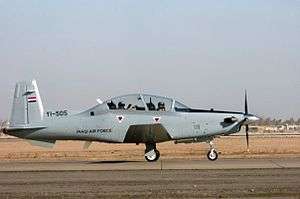 An Iraqi Air Force T-6 Texan II lands at Tikrit, Iraq | |
| Active | 1940–1944; 1944–1946; 1972–1977; 1990–1997; 2007–present |
| Country |
|
| Branch |
|
| Role | Pilot Training |
| Part of | United States Air Forces Central Command |
| Garrison/HQ | Camp Speicher |
| Engagements | Pacific Theater of Operations[1] |
| Decorations |
Distinguished Unit Citation Air Force Meritorious Unit Award Air Force Outstanding Unit Award[1] |
| Insignia | |
| 52d Expeditionary Flying Training Squadron emblem (approved 18 April 1942, reinstated June 1994)[1] |
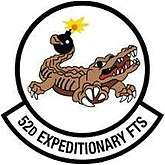 |
| 52d Flying Training Sq emblem[2] (approved c. June 1990)[1] |
.png) |
The 52d Expeditionary Flying Training Squadron is part of the Iraq Training and Advisory Mission - Air Force and is based at Camp Speicher, Tikrit, Iraq. It operates Beechcraft T-6A Texan II aircraft conducting flight training for members of the Iraqi Air Force.
It was tasked to train, educate and advise Iraqi Airmen in order to build the institutional capacity to conduct credible fixed and rotary wing flight training for the Iraqi Air Force. In late 2011, all U.S. forces were withdrawn from Iraq and the squadron was probably inactivated.
World War II
Antisubmarine warfare and heavy bomber training
The squadron was first activated at Langley Field, Virginia, as the 52d Bombardment Squadron in January 1940, one of the original squadrons of the 29th Bombardment Group. Its organization was part of the pre-World War II buildup of the United States Army Air Corps after the breakout of war in Europe. In May, it moved to MacDill Field, Florida, where it was equipped with a mix of pre-production YB-17s and early model Boeing B-17 Flying Fortresses and Douglas B-18 Bolos. The squadron was still at MacDill when the Japanese attacked Pearl Harbor, and it began to fly antisubmarine patrol missions in the Gulf of Mexico from January 1942.[1] By the summer of 1942, the U-boat threat in the Gulf began to diminish, with all German submarines being withdrawn from the area by September.[3]
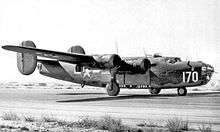
No longer needed in the Gulf, the squadron moved to Gowen Field, Idaho, where it became an Operational Training Unit (OTU).[1] The OTU program involved the use of an oversized parent unit to provide cadres to "satellite groups".[4] The 96th, 381st, 384th and 388th Bombardment Groups were all formed at Gowen in the second half of 1942.[5][6]
In 1943, the squadron exchanged its B-17s for Consolidated B-24 Liberators. The squadron mission also changed as the Army Air Forces' (AAF) need for new units diminished and its need for replacements increased. The squadron became a Replacement Training Unit (RTU).[1] Like OTUs, RTUs were oversized units, but their mission was to train individual pilots and aircrews. However, standard military units, like the 52d Squadron, were based on relatively inflexible tables of organization, and were not proving well adapted to the training mission. Accordingly a more functional system was adopted in which each base was organized into a separate numbered unit.[7] The 29th Bombardment Group and its squadrons (including the 52d) were inactivated. Its personnel and equipment, along with that of supporting units at Gowen Field were combined into the 212th AAF Base Unit (Combat Crew Training School, Heavy) on 1 April 1944.[1][8][9]
Combat in the Pacific
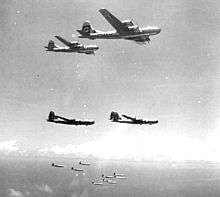
The AAF was organizing new Boeing B-29 Superfortress very heavy bombardment units, and the squadron was activated the same day at Pratt Army Air Field, Kansas. It briefly returned to flying B-17s until B-29s became available for training. It continued training with the Superfortress until December 1944.[1] Training included long range overwater flights to Borinquen Field, Puerto Rico.[10]
It deployed to North Field, Guam, where it became a component of the 314th Bombardment Wing of XXI Bomber Command. Its first combat mission was an attack of Tokyo on 25 February 1945. Until March 1945, it engaged primarily in daytime high altitude attacks on strategic targets, such as refineries and factories. The campaign against Japan switched that month and the squadron began to conduct low altitude night raids, using incendiaries against area targets. The squadron received a Distinguished Unit Citation (DUC) for a 31 March attack against an airfield at Omura, Japan. The squadron earned a second DUC in June for an attack on an industrial area of Shizuoka Prefecture, which included an aircraft factory operated by Mitsubishi and the Chigusa Arsenal.[8]
Staff Sergeant Henry E."Red" Erwin of the squadron was awarded the Medal of Honor for action that saved his B-29 during a mission over Koriyama, Japan, on 12 April 1945. Sgt Erwin was assigned to job of dropping white phosphorus bombs through a launching chute in the floor of his bomber. A bomb exploded in the chute and shot back into the plane, severely wounding Sgt Erwin and filling the plane with heavy smoke. Despite being blinded by the burning bomb, he picked it up, carried it forward to the cockpit area of the plane and threw it out an open window. Once the smoke had cleared, the pilot was able to pull the Superfortress out of a dive and recover at an emergency base.[8][11]
During Operation Iceberg, the invasion of Okinawa, the squadron was diverted from the strategic campaign against Japanese industry and attacked airfields from which kamikaze attacks were being launched against the landing force. Following VJ Day, the squadron dropped food and supplies to Allied prisoners of war and participated in several show of force missions over Japan.[8] It also conducted reconnaissance flights over Japanese cities.[12] The squadron remained on Guam until it was inactivated in March 1946.[1]
Pilot Training
It conducted undergraduate pilot training from 1972–1977 and 1990-1997.
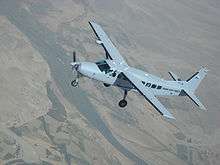

The 52d was reactivated in March 2007 as the first ever US Air Force expeditionary flying training squadron and the first flying training squadron activated in a combat zone. Its mission is to train, educate and advice Iraqi airmen to conduct undergraduate and instructor pilot training for the Iraqi Air Force.[1]
Lineage
- Constituted as the 52d Bombardment Squadron (Heavy) on 22 December 1939
- Activated on 1 February 1940
- Redesignated 52d Bombardment Squadron, Very Heavy on 28 March 1944
- Inactivated on 1 April 1944
- Activated on 1 April 1944
- Inactivated on 20 May 1946
- Redesignated 52d Flying Training Squadron on 22 March 1972
- Activated on 1 July 1972
- Inactivated on 30 September 1977
- Activated on 11 May 1990
- Inactivated on 1 April 1997
- Redesignated 52d Expeditionary Flying Training Squadron and converted to provisional status on 23 March 2007
- Activated on 29 March 2007[1]
Assignments
- 29th Bombardment Group, 1 February 1940 – 1 April 1944
- 29th Bombardment Group, 1 April 1944 – 20 May 1946
- 29th Flying Training Wing, 1 July 1972 – 30 September 1977
- 64th Flying Training Wing, 11 May 1990
- 64th Operations Group, 15 December 1991 – 1 April 1997
- 370th Air Expeditionary Advisory Group, 29 March 2007 – 1 November 2008[1]
- 321st Air Expeditionary Advisory Group, 1 November 2008 – present
Stations
|
|
Aircraft
|
|
References
Notes
- 1 2 3 4 5 6 7 8 9 10 11 12 13 14 15 Robertson, Patsy (September 11, 2008). "Factsheet 52 Espeditionary Flying Training Squadron (ACC)". Air Force Historical Research Agency. Retrieved December 18, 2017.
- ↑ "Approved insignia for: 52d Flying Training Squadron". National Archives Catalog. November 7, 1990. Retrieved December 19, 2017.
- ↑ Warnock, p. 16
- ↑ Craven & Cate, Introduction, p. xxxvi
- ↑ Maurer, Combat Units, pp. 166, 269, 271, 276
- ↑ "Abstract, History 29 Bombardment Group Nov 1943". Air Force History Index. Retrieved June 5, 2018.
- ↑ Goss, p. 75
- 1 2 3 4 Maurer, Combat Units, pp. 81-82
- ↑ "Abstract, History Gowen Field, Feb-Mar 1945". Air Force History Index. Retrieved June 5, 2018.
- ↑ "Abstract, History 29 Bombardment Group Jan 1945". Air Force History Index. Retrieved June 6, 2018.
- ↑ No byline. "U.S. Air Force Heritage: Master Sgt. Henry E. "Red" Erwin". United States Air Force Public Affairs. Archived from the original on June 29, 2011. Retrieved June 15, 2018.
- ↑ "Abstract, History 29 Bombardment Group Aug-Sep 1945". Air Force History Index. Retrieved June 6, 2018.
Bibliography
![]()
- Craven, Wesley F & Cate, James L, ed. (1955). The Army Air Forces in World War II (PDF). Vol. VI, Men & Planes. Chicago, IL: University of Chicago Press. LCCN 48003657. OCLC 704158. Retrieved December 17, 2016.
- Goss, William A. (1955). "The Organization and its Responsibilities, Chapter 2 The AAF". In Craven, Wesley F & Cate, James L. The Army Air Forces in World War II (PDF). Vol. VI, Men & Planes. Chicago, IL: University of Chicago Press. LCCN 48003657. OCLC 704158. Retrieved December 17, 2016.
- Maurer, Maurer, ed. (1983) [1961]. Air Force Combat Units of World War II (PDF) (reprint ed.). Washington, DC: Office of Air Force History. ISBN 0-912799-02-1. LCCN 61060979.
- Maurer, Maurer, ed. (1982) [1969]. Combat Squadrons of the Air Force, World War II (PDF) (reprint ed.). Washington, DC: Office of Air Force History. ISBN 0-405-12194-6. LCCN 70605402. OCLC 72556.
- Ravenstein, Charles A. (1984). Air Force Combat Wings, Lineage & Honors Histories 1947-1977 (PDF). Washington, DC: Office of Air Force History. ISBN 0-912799-12-9.
- Warnock, Timothy. "The Battle Against the U-Boat in the American Theater" (PDF). Bolling AFB, DC: Air Force History Support Office. Retrieved June 22, 2015.
External links
- MNF-Iraq Article
- Stars and Stripes Article
- Washington Post Article
- Randolph Air Force Base website - 2000 Hour Milestone
- US Air Force Link website - 3000 Hour Milestone
- Defence Talk website - First Iraqi AF Pilots Graduate
- CNN - Iraq Air Force Pilots Graduate
- Vance AFB Article
- Aviation Week Article
- Kirkuk Regional Air Base website - 5000 Hour Milestone
- Air Education and Training Command Article
- Kirkuk Regional Air Base website - Class 68 Graduation
- AOPA Article
- Kirkuk Regional Air Base website - 7500 Hour Milestone
- Kirkuk Regional Air Base website - Class 69 Graduation
- NPR - New Generation Of Iraqi Military Pilots Looks To Sky
- Kirkuk Regional Air Base website - Class 70 Graduation
- T-6A Arrives at COB Speicher
- Iraqi Air Force College Presents Bright Future at COB Speicher
- Airmen to Train Iraqi Air Force College Students at COB Speicher
- Airmen Train Iraqi Air Force Instructor Pilots


.png)